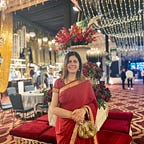DEJHOR AND THE KASHMIRI WOMAN
Very often a married Kashmiri Pandit woman gets identified by the two long gold chains with pendants that hang from both her ears. That’s called a Dejhor.
It is akin to a Mangalsutra worn by most Hindu women across the country. A Kashmiri woman first wears it on a day prior to her wedding day or the day of the Lagan or the Saptapadi. The ceremony during which the Dejhor is put into the pierced centre of the ears, is called Devgoan. These holes are usually pierced along with the ones in the lobes during childhood, but definitely a few months before the wedding day, as, being in the cartilage, they take time to heal.
This Devgoan is usually held a day before the wedding day. It marks the bride and groom’s transition from Brahmacharya Ashram to Grahasthya Ashram. The bride and the groom, in their respective homes, are given Kanyi Shraan — a pre-nuptial bathing ritual. The Maamanye (maternal aunt) cleans the Vuz (main lobby of the house) and the bride/groom is made to sit at the centre. Water mixed with milk is poured over her/him through a muslin cloth which is held by four small girls(Kanya), one at each end. Following the bath, all old clothes or accessories on the bride/groom are given away and they change into new clothes which are gifted by the mother’s side of the family — typically a saree and kurta-pyjamas respectively.
A fire is lit in the Havan Kund and the Gor (priest in Kashmiri) conducts the Devgoan ceremony in front of this sacred fire. The bride/groom offer prayers to Parvati and Shiva as per Vedic rituals performed by the priest. They observe a fast before the puja. The bride’s gold ornaments and utensils to be given to her by her family are placed in front of the yagna and are sanctified during the ceremony.
Amongst all the ornaments that a Kashmiri bride wears, the Atth, Athoor and Dejhor are the most significant ones. This Dejhor has a deep spiritual connotation. Made of gold, the Dejhor is a shatkon or hexagon-shaped pendulum and Atth is the gold chain that holds the Dejhor. The hexagonal shape represents the union of Shiva & Shakti. At the bottom of the Atth is a round shaped ornament which is called the Athoor. Athoor can be of gold or it can also be made of shiny-shimmery golden or silver threads like tilla, solme , dabka or pearls. This ensemble is worn in both the ears. During the Devgon, the parents of the bride put the Dejhor in her ears hanging it using the Narivan (red thread). Later, on the wedding day, after the bride goes to her in-laws’ place, they replace the red thread of the Dejhor with the gold Atth thus signifying the union of two individuals and the respective families.
While the Atth-Dejhor is a permanent fixture, the Athoor is changed often like an accessory. A fresh one is worn at every important occasion like a birthday — one’s own or that of the husband’s/kids’, a wedding of a family member, important festivals etc. It usually comes from the mother’s side. They are becoming fancier and more fashionable by the day. While I have just two pairs of Atth-Dejhor, I must have hundreds of the ones with colourful threads or beads as they keep arriving from my mother at every happy occasion!
For any feedback/info please write to me at namratawakhloo@gmail.com
